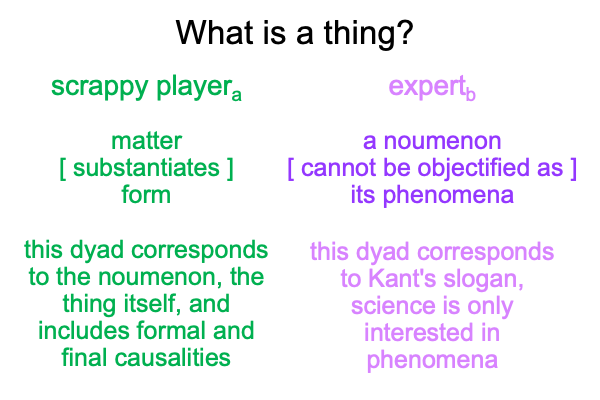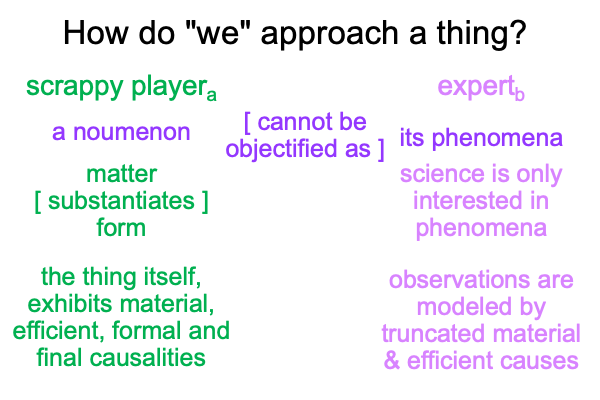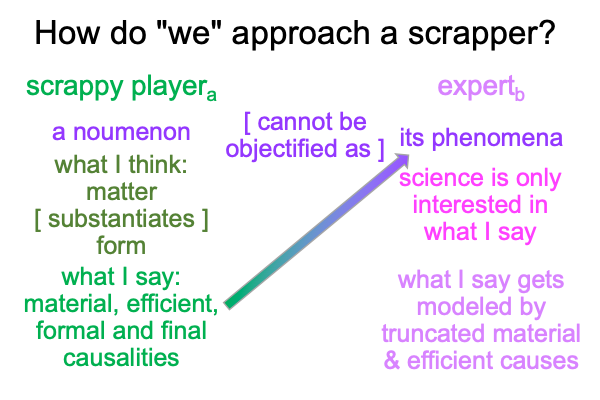0706 Chapter ten is titled, “Planet Vulnerable”.
In this chapter, Stiles confronts success2c for the one of scientism3c in the Fourth Battle of The Enlightenment Gods: Empirio-Normative Domination of Citizen-Subject Populations.
I suppose that spoken words are supposed to convey reality and bring us into a common understanding. In our post-truth condition, the spoken words that the media utter convey a pseudo-reality (a web of narratives) that brings us into communion whether we like it or not (especially after media reports accompanying the narrative are shown to omit crucial truths).
0707 Currently, American media likes to label this communion as “our democracy”.
I guess that the administrative state is too embarrassed to call it “our tyranny”.
Labeling is crucial.
I love Stiles quotes, posted in the margins as addenda. Here is my restatement of one quote.
“By the skillful and sustained use of propaganda, one can make a people see that our tyranny is ‘our democracy’ and that our success2c is their success2a.”
0708 Planet Vulnerable makes me think about both history and logic.
Why are scrappy players slowly becoming more and more vulnerable?
0709 One answer starts with a question, asking “What is the content-level actuality2a?”, and ends with the question, wondering, “What about domination?”.
Steve Fuller looks back to the start of the modern era, when mechanical philosophers completely confused theologians, by introducing a concept that seems like Aristotle’s matter and form, but really is not. The concept is “phenomena” defined as “the observable and measurable aspects of a thing”. It raises a question, asking, “What is a thing?”
Here is how the question breaks. Theologians are reduced to the scrappy player level. Mechanical philosophers are elevated to the expert level.

0710 To start, for the natural philosopher (typically, a theologian of sorts), a thing is a hylomorphe composed of two real elements, matter and form. Matter accounts for presence and addresses questions like, “What is it made of?”. Formaccounts for shape and function and addresses questions like, “What is it supposed to do?”
In terms of Peirce’s three categories, hylomorphic structures should belong to secondness. Secondness consists of two contiguous real elements. The contiguities in the above figure are placed in brackets. Experts trained in Aristotle may shudder when reading the label that I put into brackets. All I am doing is adding one more technical definition to the term, “substance”.
“Substance” is “the contiguity between matter and form”.
0711 Next, for the mechanical philosopher, the expert, a thing is also a dyad. A noumenon (the thing itself) [cannot be objectified as] its phenomena (its observable and measurable facets). There is good reason why Kant insisted on the importance of the noumenon, the thing itself. Observations and measurements of phenomena may go bonkers. So, there must be a noumenon as a reality check.
0712 For example, on a summer day, I measure the rise in ambient air temperature from six to nine o’clock in the morning. Then, I graph the data and model the data with a linear extrapolation. I then predict that, by ten o’clock at night, the ambient air temperature will be greater than the boiling point of water, and we are all going to die!
Of course, my model does not account for the noumenon, the cyclical nature of the day, when the sun warms the earth in proportion to its location in the heavens, and then sets, and does not warm the earth until the following morning.
0713 The empirio-schematic judgment is a triadic relation, where disciplinary language (relation) brings observations and measurements of phenomena (what is) into relation with mathematical and mechanical models (what ought to be). Notice that the word, “noumenon”, does not appear in the empirio-schematic judgment. Since the noumenon is a whole, it cannot be directly measured. But, its phenomena can. That is why scientists fixate on phenomena and ignore their noumenon.
Fixation and ignorance are threads woven into the fabric of The Age of Ideas. Experts fixate on phenomena. Experts ignore the noumenon. In the process, scientist cultivate material and efficient causes that are divorced from final and formal causes. They neglect final and formal causes.
0714 What does this discussion imply?
I suppose it means that the previous figure needs to be adjusted.

0715 Oh, that leads to more difficulties.
Aristotle’s foundational hylomorphe, matter [substance] form, corresponds to the noumenon, the thing itself, that scientists ignore. Indeed, when a scientist becomes a triumphalist, he wants to replace the noumenon with his mathematical or mechanical model. Then, the model (substituting for the noumenon) [can be objectified by] its phenomena.
0716 If the scrappy player level is occupied by theologians and natural philosophers, then what the scrappy player thinksand what the scrappy player says cannot be objectified as phenomena, that is observable and measurable facets of the thing itself.
How so?
For the most part, scrappy players say what they think.
Both thinking and talking represent the noumenon (but may, on occasion, concern phenomena, its observable and measurable facets).
So, what I think is like matter and what I say is like form. Matter [substance] form associates to a noumenon, a thing itself.
0717 This is confusing.
I thought that what I think corresponds to a noumenon and what I say corresponds to its phenomena.
It does for the psychometric sciences3b.
What I think [cannot be objectified as] what I say is a construct that is imposed by the post-truth condition itself. This actuality2a occurs when reason3a,1a is defined as the intellect3a contextualizing the will1a. When reason3a,1a is so defined, then expertise3b can virtually situate it3a,1a.
0718 So, maybe, I need to change the picture once again, where the person on the crappy player level becomes a thing(that can be studied by the psychometric sciences).

Ah, that is better.
0719 What I think corresponds to the first abstraction in natural philosophy according to Comments on Jacques Maritain’s Book (1935) Natural Philosophy. A psychometric scientist cannot observe or measure this noumenon.
0720 What I say corresponds to a philosophical discussion concerning material, efficient, formal and final causalities.
Since a psychometric scientist3b can observe and measure the phenomena of what I say2a, then what I say concerning the subject of investigation2a may go into the corresponding model of value2b. The scientist must be selective about what is observed and measured1b. The scientist must discriminate in so far as the phenomena2a must apply to what the scientist intends to model2b. Aristotle’s four causes are acknowledged only in so far as a scientific model (with no metaphysics) can explain their content and import.
0721 What can go wrong? What is missing?
